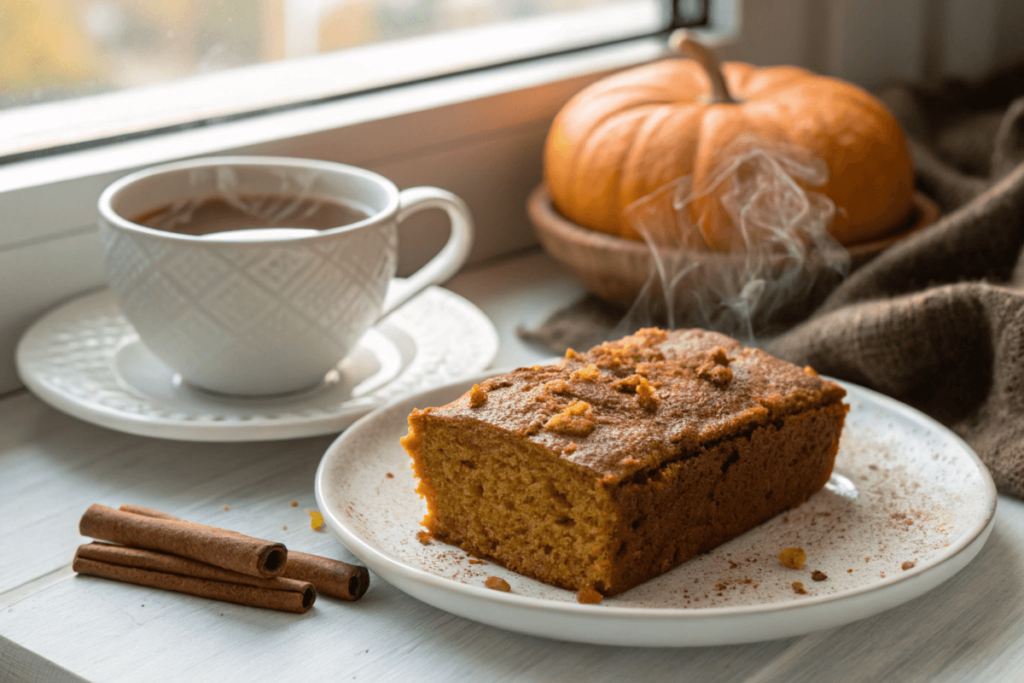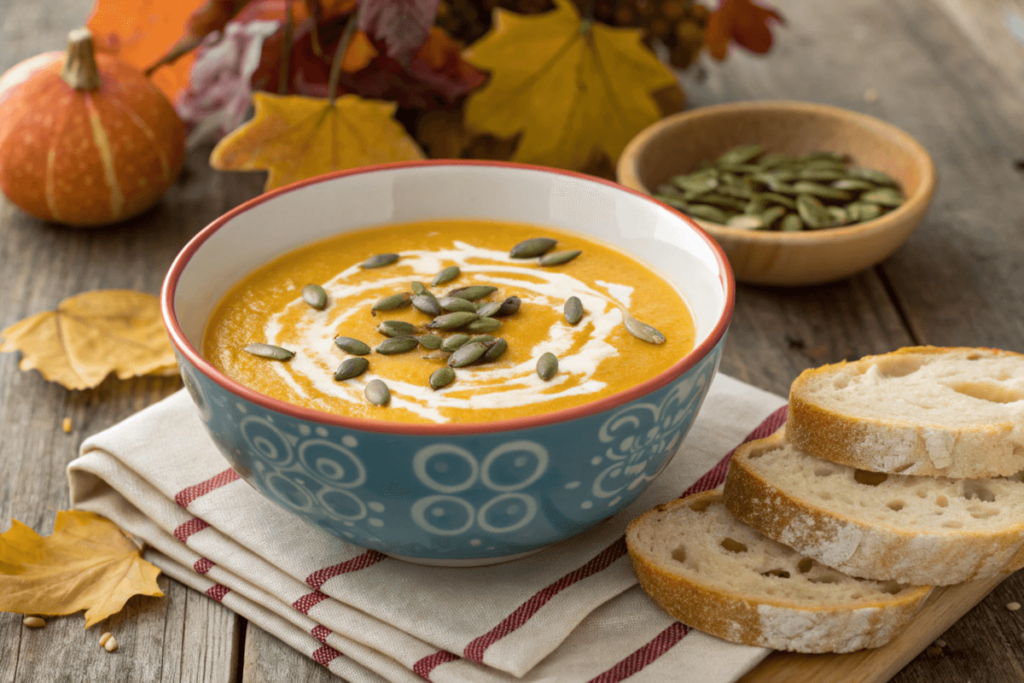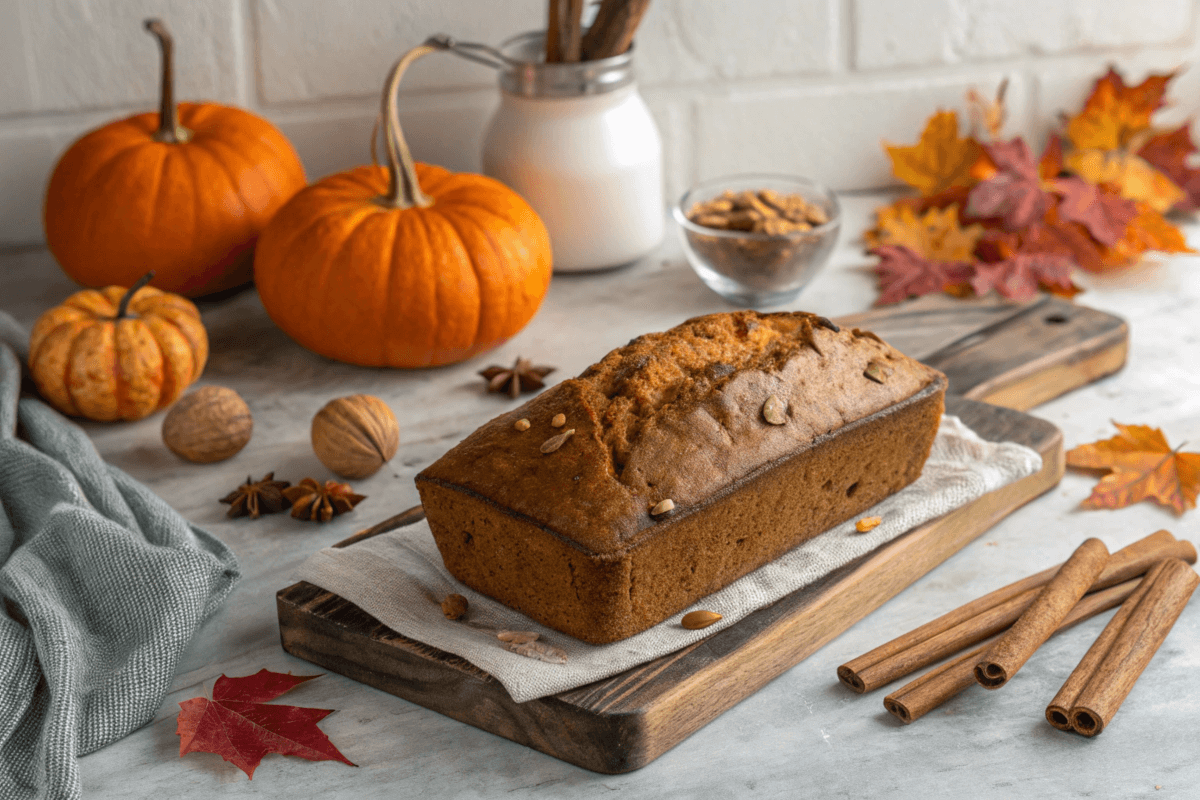Does Pumpkin Bread Have Any Health Benefits?
Pumpkin bread is a seasonal favorite, cherished for its warm, comforting flavors. But does pumpkin bread have any health benefits? This article dives into its nutritional value, explores its potential health perks and drawbacks, and offers tips for making healthier versions. Whether you’re an avid baker or simply curious, you’ll find out if this fall treat can fit into a healthy lifestyle.
Introduction to Pumpkin Bread and Its Popularity
What Is Pumpkin Bread?
Pumpkin bread is a moist, sweet loaf made with pumpkin puree, a blend of fall spices like cinnamon and nutmeg, and often enriched with sugar and fats. Its iconic flavor makes it a staple during the autumn and winter months. Whether enjoyed with coffee, as a snack, or even as dessert, pumpkin bread has carved out its place as a beloved seasonal treat.
The Appeal of Pumpkin Bread in Fall Seasons
When the leaves turn, and the air gets crisp, pumpkin bread becomes a symbol of coziness. Its nostalgic aroma, combined with the popularity of pumpkin-spiced everything, contributes to its seasonal charm. From bakeries to homemade recipes, this treat offers both familiarity and comfort.
Why Health Concerns Arise Around Pumpkin Bread
While pumpkin itself is a nutritional powerhouse, the additional ingredients in pumpkin bread—such as sugar, butter, and white flour—can diminish its health benefits. These elements make people question its place in a balanced diet. Is it an occasional indulgence, or can it offer real health value? The answer lies in its preparation and portion size.
Nutritional Profile of Pumpkin
Key Nutrients Found in Pumpkin
Pumpkin is packed with essential nutrients, making it a healthy addition to many dishes. Its most notable nutrient is vitamin A, with a single serving providing over 200% of the daily recommended intake. Vitamin A promotes healthy vision, supports the immune system, and contributes to skin health. Additionally, pumpkin contains a wealth of beta-carotene, an antioxidant that helps combat free radical damage.
Fiber is another significant component of pumpkin, aiding in digestion and helping you feel full for longer periods. It’s also a good source of potassium, which supports heart health and maintains proper muscle function. Not to be overlooked, pumpkin offers smaller amounts of magnesium, vitamin C, and vitamin E, all contributing to overall health.
Health Benefits of Vitamin A, Fiber, and Antioxidants
Vitamin A is vital for maintaining good eyesight, especially in low-light conditions. It also supports immune health by enhancing the function of white blood cells. Meanwhile, the fiber in pumpkin promotes a healthy gut, prevents constipation, and stabilizes blood sugar levels. Antioxidants such as beta-carotene and vitamins C and E play a critical role in protecting the body from oxidative stress, which can lead to chronic diseases.
The Role of Potassium in Health
Potassium is essential for maintaining normal blood pressure and reducing the risk of cardiovascular issues. By countering the effects of excess sodium, potassium helps keep your heart in check. Regular consumption of potassium-rich foods, like pumpkin, may reduce the risk of strokes and support bone density. With these nutritional attributes, it’s clear that pumpkin can be a great addition to a balanced diet, and by extension, so can pumpkin bread—when prepared thoughtfully.
Common Ingredients in Pumpkin Bread and Their Impact
The Role of Sugar in Pumpkin Bread
Sugar is a major ingredient in most pumpkin bread recipes, and it’s one of the primary reasons this treat can veer into unhealthy territory. Excessive sugar intake contributes to empty calories, weight gain, and even spikes in blood sugar. For those watching their sugar intake, reducing the amount of sugar in recipes or using natural alternatives like honey can help make pumpkin bread a healthier option.
Fats: Healthy vs. Unhealthy Choices
The type of fat used in pumpkin bread significantly affects its nutritional profile. Butter and shortening, often used in traditional recipes, contain saturated fats, which can raise cholesterol levels if consumed in excess. Healthier alternatives, such as olive oil or avocado oil, provide unsaturated fats that support heart health. Choosing the right fat can help balance the indulgence with some nutritional benefits.
Spices and Their Nutritional Benefits
Pumpkin bread wouldn’t be complete without its signature blend of spices like cinnamon, nutmeg, and ginger. Not only do these spices enhance flavor, but they also come with health perks. Cinnamon, for instance, has been linked to improved blood sugar control and reduced inflammation. Ginger boasts anti-inflammatory properties, while nutmeg can aid digestion and boost overall flavor.
If you’re exploring healthier recipes, you might enjoy this Pumpkin-Banana Loaf from Tester Recipes, which combines pumpkin’s benefits with the natural sweetness of bananas for a balanced treat.
By understanding these ingredients and their impacts, you can make better choices and answer the question: Does pumpkin bread have any health benefits?—with a confident yes, when crafted mindfully.
Health Benefits of Pumpkin Bread

How Pumpkin Bread Can Contribute to a Balanced Diet
Pumpkin bread can be more than just a tasty indulgence—it can support a balanced diet when made with wholesome ingredients. Thanks to its pumpkin content, it offers vitamins, minerals, and fiber that promote digestive health and help regulate blood sugar. Swapping refined flour for whole-wheat flour and reducing added sugar enhances its nutritional value, making it a guilt-free treat.
Additionally, the fiber and antioxidants from pumpkin help you feel fuller for longer, reducing the urge to overeat. Incorporating pumpkin bread into a balanced diet ensures you’re not sacrificing taste for health.
Benefits of Homemade Pumpkin Bread Over Store-Bought
Store-bought pumpkin bread often contains high levels of sugar, preservatives, and artificial flavors. These additives not only diminish its health benefits but can also increase calorie content. Making pumpkin bread at home gives you control over the ingredients, allowing you to limit unhealthy elements while boosting its nutritional value.
For instance, homemade versions let you include nutrient-dense add-ins like walnuts, chia seeds, or dark chocolate, which bring additional health perks. A recipe like Chocolate Chip Pumpkin Bread from Tester Recipes is a great example of how to enjoy a healthy twist on this classic treat.
The Nutritional Role of Pumpkin in a Sweet Treat
Pumpkin is the star ingredient, offering a rich supply of vitamin A, fiber, and potassium. These nutrients contribute to better vision, improved digestion, and heart health. Even as a sweet bread, the presence of pumpkin makes it a better alternative to other calorie-dense desserts. The question “Does pumpkin bread have any health benefits?” can indeed be answered positively when it’s made thoughtfully.
Tips for Making Healthier Pumpkin Bread
Using Whole-Wheat Flour for Added Fiber
One of the easiest ways to boost the health value of pumpkin bread is by substituting white flour with whole-wheat flour. Whole-wheat flour is rich in fiber, which aids digestion, stabilizes blood sugar levels, and helps you stay full longer. Not only does this simple swap enhance the bread’s nutritional profile, but it also adds a slightly nutty flavor that complements the pumpkin and spices.
Reducing Sugar and Choosing Natural Sweeteners
Reducing sugar content is another way to make pumpkin bread healthier. Too much sugar adds empty calories and can cause energy crashes. Instead, try natural sweeteners like maple syrup, honey, or even mashed bananas for a touch of sweetness. These alternatives bring extra nutrients without compromising flavor.
Opting for Healthy Fats in Recipes
Replace butter or shortening with healthier fats like coconut oil or olive oil. These fats are heart-friendly and enhance the bread’s moist texture. They also add subtle flavor nuances that pair well with pumpkin. If you’re looking for inspiration, check out our recipe for Pumpkin-Banana Loaf on Tester Recipes for a delicious example of using healthy fats.
Adding Extra Pumpkin for More Nutritional Value
Increasing the amount of pumpkin in your bread is a simple way to up its health benefits. Since pumpkin is packed with vitamin A, potassium, and antioxidants, a higher pumpkin content boosts the bread’s nutritional profile while keeping it moist and flavorful. Plus, the natural sweetness of pumpkin can help reduce the need for added sugar.
For more delicious recipes and baking tips, explore Pumpkin Sourdough Bread for a creative twist on classic pumpkin bread.
By following these tips, you can enjoy a healthier version of pumpkin bread without sacrificing its signature taste and comforting qualities.Part 6: Moderation and Portion Control
Understanding Serving Sizes
When it comes to pumpkin bread, serving size is key. While it’s tempting to enjoy a large slice, portion control ensures that you don’t overdo it on calories, sugar, or fats. A standard serving of pumpkin bread is typically one slice, which contains around 150–200 calories depending on the recipe. Eating more than this can quickly add up, even if the bread is homemade and uses healthier ingredients.
Practicing mindful eating, such as savoring each bite, helps you enjoy pumpkin bread without overindulging. This way, you can answer the question Does pumpkin bread have any health benefits? with a confident yes, as part of a balanced diet.
Managing Caloric Intake While Enjoying Pumpkin Bread
To keep your calorie intake in check, consider pairing your pumpkin bread with nutrient-dense sides like fresh fruit or a protein-rich yogurt. This combination balances your snack, providing lasting energy and reducing the likelihood of overeating. Additionally, avoid frequent consumption, especially of store-bought versions, which may contain hidden sugars and unhealthy fats.
Keeping portion sizes moderate and incorporating pumpkin bread as an occasional treat rather than a daily staple allows you to enjoy its flavors guilt-free.
When to Indulge and When to Avoid
Timing matters when enjoying pumpkin bread. It’s best enjoyed as a morning snack or as part of a healthy breakfast to fuel your day. Avoid having it late at night, as the sugar content could disrupt sleep or lead to unnecessary calorie intake before bed. By being mindful of when and how you indulge, you can enjoy this seasonal favorite without compromising your health.
Alternatives to Pumpkin Bread for Healthy Eating
Pumpkin Soup: A Nutrient-Dense Option
If you’re looking to enjoy pumpkin in a healthier form, consider pumpkin soup. Made with fresh or canned pumpkin, this savory dish provides all the benefits of vitamin A, fiber, and potassium without the added sugar or fats often found in baked goods. Add spices like cumin and a splash of coconut milk for a creamy, nutritious meal that’s perfect for cooler weather.

Pumpkin Smoothies: A Healthy Start to the Day
Pumpkin smoothies are another great alternative for those who love pumpkin flavor but want to avoid the high-calorie content of pumpkin bread. Combine pumpkin puree, almond milk, a banana, and a dash of cinnamon for a refreshing and nutrient-packed breakfast or snack. Smoothies offer a versatile way to enjoy the benefits of pumpkin while keeping sugar intake low.
Pumpkin Pancakes and Other Breakfast Ideas
For a hearty breakfast, try making pumpkin pancakes using whole-wheat flour and natural sweeteners. These pancakes capture the comforting flavors of fall while delivering more fiber and nutrients than traditional recipes. Alternatively, you can incorporate pumpkin into oatmeal or yogurt bowls for a quick, healthy breakfast packed with antioxidants and natural sweetness.
By exploring these alternatives, you can still enjoy the deliciousness of pumpkin while prioritizing health. Whether it’s soup, smoothies, or pancakes, these options allow you to embrace the season in a nutritious way.
FAQs About Pumpkin Bread
Is Pumpkin Bread Good for Weight Loss?
Pumpkin bread isn’t typically considered a weight-loss food due to its sugar and calorie content. However, by making a few smart tweaks, such as using whole-wheat flour and reducing sugar, you can enjoy a lighter version. Eating it in moderation and pairing it with protein or fiber-rich foods can also help manage hunger. So, while it’s not a weight-loss miracle, it can fit into a balanced diet when approached thoughtfully.
Can Pumpkin Bread Lower Cholesterol?
The pumpkin in pumpkin bread contains fiber, which can help lower cholesterol levels. But the bread’s overall effect depends on the recipe. Using healthy fats like olive oil and avoiding saturated fats from butter can reduce its cholesterol-raising potential. Adding nuts or seeds to your bread can further boost its heart-healthy properties. The answer to Does pumpkin bread have any health benefits? includes potential support for heart health, especially when healthier ingredients are used.
Is Pumpkin Bread Suitable for Diabetics?
Traditional pumpkin bread may not be the best choice for people with diabetes due to its high sugar content. However, by replacing refined sugar with natural sweeteners like stevia or reducing the amount altogether, you can create a version that’s more diabetic-friendly. Always consult your doctor or dietitian to ensure it aligns with your dietary needs.
Can Pregnant Women Eat Pumpkin Bread?
Yes, pregnant women can enjoy pumpkin bread, but it’s essential to watch the sugar and fat content. Pumpkin itself is rich in vitamins and minerals, including folate, which supports healthy fetal development. For a healthier option, opt for homemade pumpkin bread with reduced sugar and added nutrients like nuts or chia seeds.
Conclusion: A Balanced Approach to Pumpkin Bread
Summarizing Key Health Benefits and Drawbacks
Pumpkin bread, when prepared thoughtfully, offers a range of health benefits. It contains vitamins, fiber, and antioxidants from pumpkin, which support overall well-being. However, its high sugar and fat content in traditional recipes can counteract these advantages. Homemade versions allow you to control these elements, making pumpkin bread a healthier choice. The question Does pumpkin bread have any health benefits? can be answered with a resounding yes—provided it’s enjoyed in moderation and made with nutritious ingredients.
How to Incorporate Pumpkin Bread in a Healthy Diet
Incorporating pumpkin bread into a healthy diet starts with making smarter ingredient choices. Choose whole-grain flours, healthy fats, and reduce sugar to elevate its nutritional value. Enjoy it as a part of balanced meals or as an occasional treat. Pairing pumpkin bread with nutrient-dense sides like yogurt or fresh fruit can help balance its calorie content. With these strategies, you can savor this seasonal delight while keeping your health in check.

